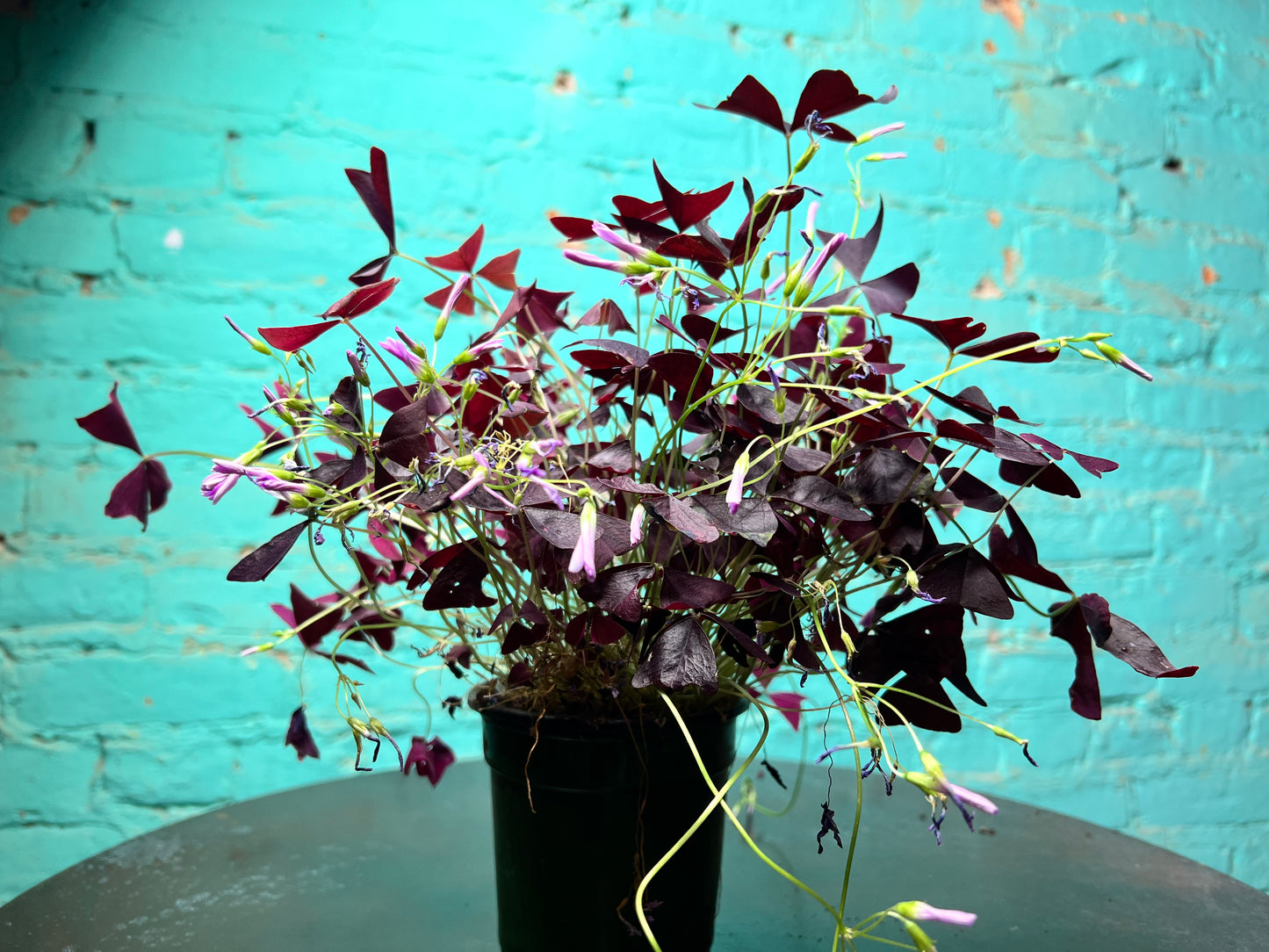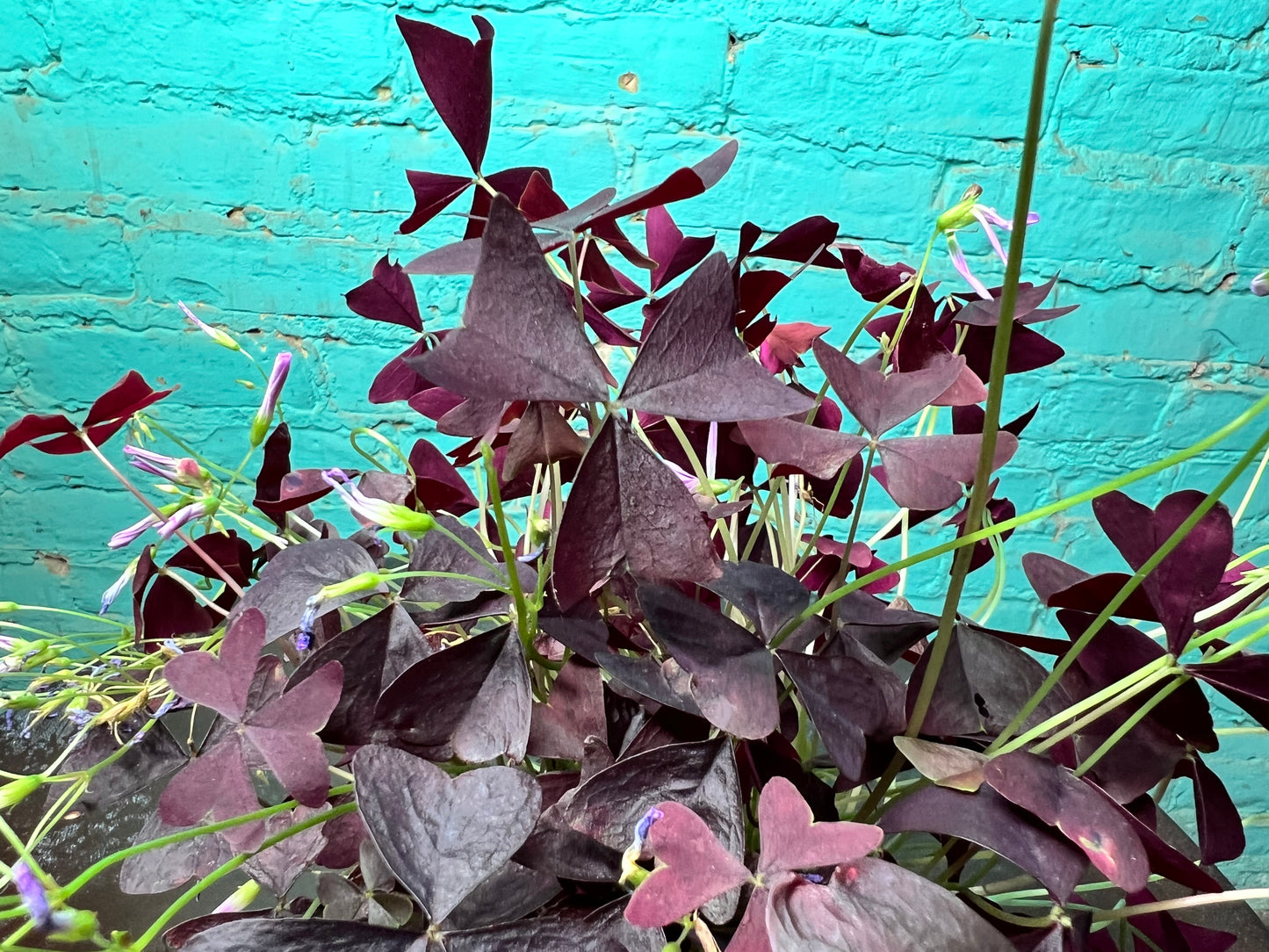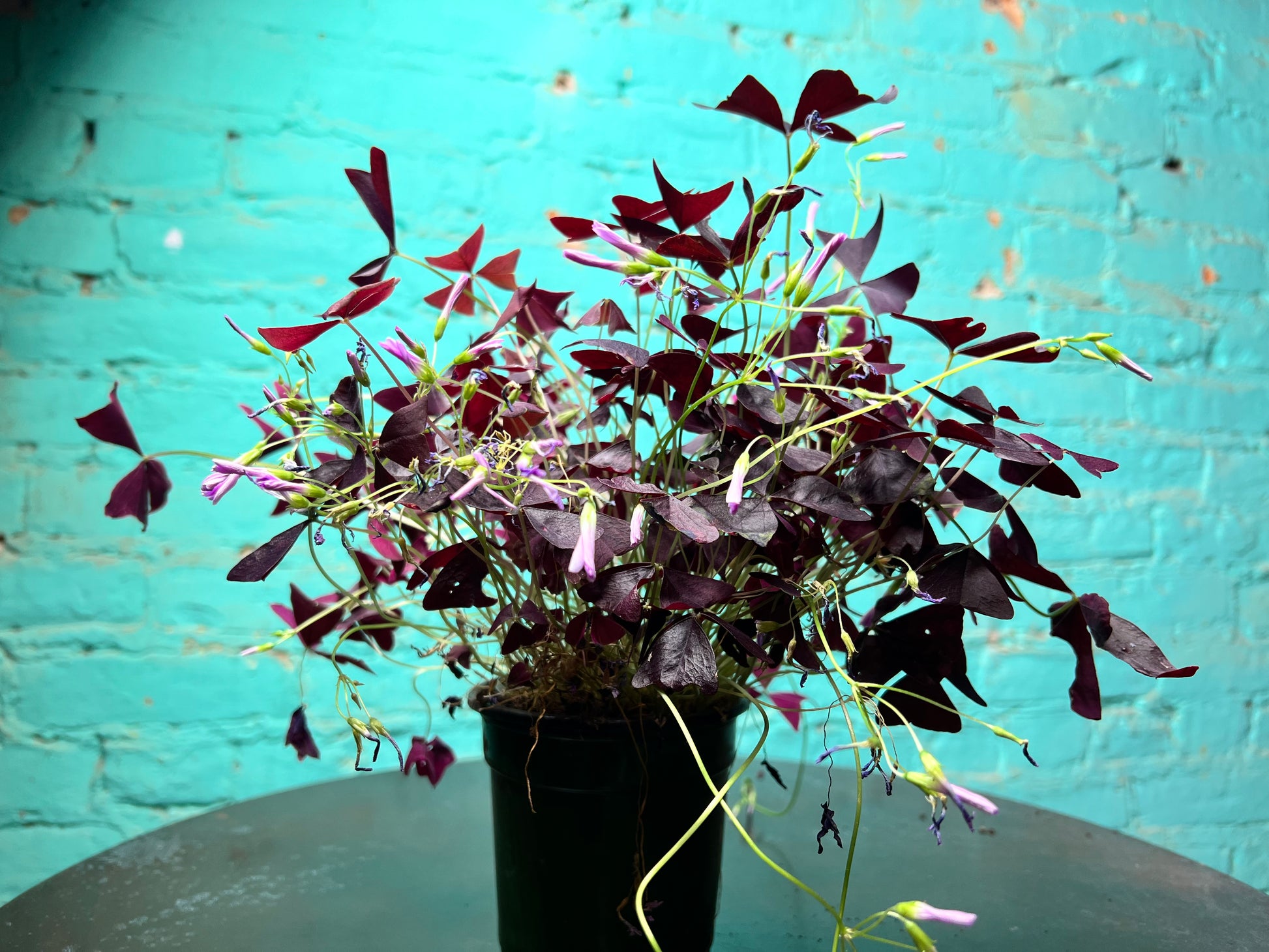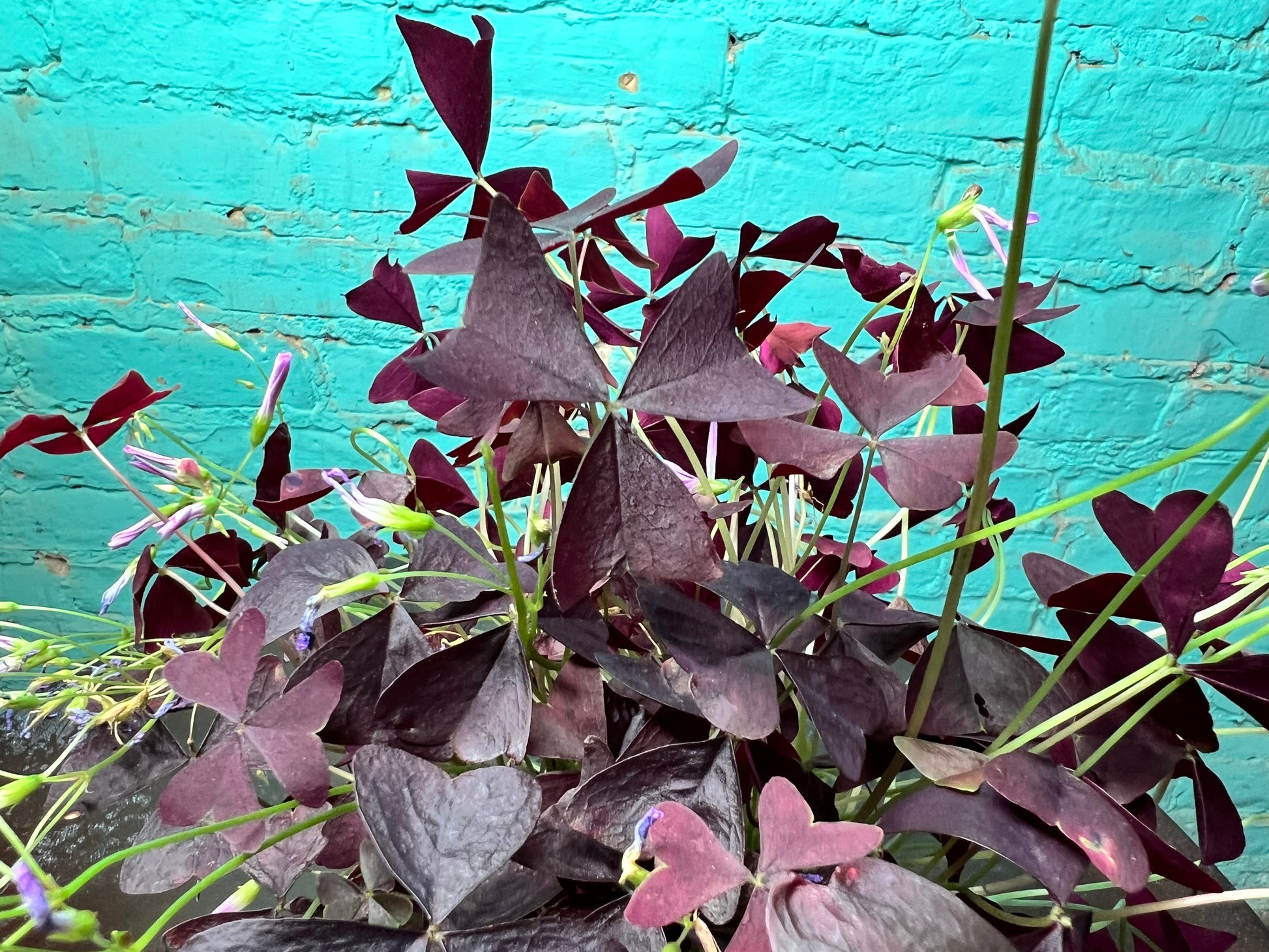The Rooted Plant Shop
Purple Shamrocks 4”
Purple Shamrocks 4”
Couldn't load pickup availability
Shamrocks (Oxalis) are relatively easy to care for, but they do need the right conditions to thrive. Here are some tips to keep your shamrock plant happy and healthy:
Light: Shamrocks love bright, indirect light. Place your plant near a window with plenty of light but avoid direct sunlight, which can scorch the leaves. If you don’t have enough natural light, you can use grow lights.
Watering: Keep the soil consistently moist but not soggy. Water when the top inch of soil feels dry, but make sure the pot has good drainage to avoid waterlogging, which can lead to root rot.
Temperature: Shamrocks prefer cooler temperatures (60-70°F. Avoid placing them in drafty areas or near heat sources, as they can suffer in hot, dry conditions.
Humidity: They thrive in moderate humidity. If the air is dry, especially in winter, you can increase humidity by placing a humidifier nearby or placing the pot on a tray of pebbles and water.
Fertilizing: During the growing season (spring and summer), fertilize your shamrock with a balanced, water-soluble fertilizer every 4-6 weeks. In fall and winter, when the plant is dormant, reduce or stop fertilizing.
Dormancy: Shamrocks go dormant in the winter. The leaves may wilt and die back, but this is normal. During this time, reduce watering and let the plant rest. You can either move the pot to a cooler spot or leave it in its regular spot with less water. It should regrow in the spring.Repotting: Shamrocks don’t need frequent repotting, but if they outgrow their pot, repot them in fresh, well-draining soil. This is best done in the spring, during the plant’s active growing period.
Yellowing Leaves
- Cause: Yellow leaves can be a sign of overwatering, underwatering, or a nutrient deficiency.
-
Solution:
- Overwatering: Ensure the plant is in well-draining soil and that the pot has proper drainage. Allow the top of the soil to dry out before watering again.
- Underwatering: Water the plant thoroughly if the soil is too dry. Make sure you're watering consistently.
- Nutrient Deficiency: If yellowing persists, try fertilizing with a balanced, water-soluble fertilizer.
Brown Leaf Tips or Edges
- Cause: Brown tips can result from low humidity, underwatering, or exposure to drafts or heat.
-
Solution:
- Humidity: Shamrocks prefer moderate humidity. Increase humidity by placing the pot on a humidity tray or using a humidifier.
- Watering: Ensure you are watering consistently but not excessively. Check the soil's moisture level before watering.
- Temperature: Keep the plant in a place with stable temperatures, avoiding drafts and direct heat sources.
Wilting or Drooping Leaves
- Cause: Wilting can occur from underwatering or overwatering, or it could be a sign that the plant is entering its dormant period.
-
Solution:
- Watering: Check if the soil is dry. If underwatered, water thoroughly, but ensure the pot has good drainage. If overwatered, check the roots for rot and let the soil dry out completely.
- Dormancy: Shamrocks often go dormant in the winter. If the leaves wilt during this time, it’s normal. Reduce watering and let the plant rest.
Pest Infestation (Aphids, Mealybugs, or Spider Mites)
- Cause: These pests can be attracted to shamrocks, causing leaf damage and stunted growth.
-
Solution:
- Manual Removal: For small infestations, remove pests manually using a damp cloth or by gently spraying the plant with water.
- Insecticidal Soap: Use insecticidal soap or neem oil to treat more serious infestations. Apply it according to the package instructions, ensuring you cover both sides of the leaves.
Leggy Growth or Lack of Flowers
- Cause: This can occur if the plant isn’t getting enough light, or if it’s not in its active growing season.
-
Solution:
- Light: Move the plant to a brighter location where it gets indirect light. If you’re growing it indoors, supplement with a grow light if necessary.
- Dormancy: Shamrocks typically bloom in the spring and summer. If it’s winter and there are no flowers, it might just be resting, so be patient.
Root Rot
- Cause: Root rot happens when the plant is overwatered or the soil doesn’t drain well, causing the roots to sit in stagnant water.
-
Solution:
- Repotting: If root rot is suspected, remove the plant from the pot and check the roots. Trim off any blackened or mushy roots. Repot the plant in fresh, well-draining soil and a pot with drainage holes. Be sure to let the soil dry out between waterings.
Leaf Curling
- Cause: Curling leaves can be a sign of stress due to inconsistent watering, temperature fluctuations, or pest infestations.
-
Solution:
- Watering Consistency: Ensure you are watering the plant when the top inch of soil is dry, and make sure the pot drains well.
- Temperature: Avoid placing the plant in places where temperatures fluctuate dramatically, such as near a draft or heater.
- Pests: Check for pests, such as aphids or spider mites, which can cause leaf distortion. Treat with insecticidal soap if necessary.
Share



Let customers speak for us
from 324 reviewsRic Rac Cactus (fish bone) 8” basket

First off she worked with me specifically to where I could get both of these at a really good price and I just gotta say these are the best condition ones I’ve seen yet they are so beautiful and I will continue to be buying from the shop 100000/10❤️❤️❤️

It came so perfectly packaged. The plant was in perfect condition. And looks exactly like the photo definitely worth some money and I would buy it again. Love the shop overall.1000/100

I have been wanting to get a Jose bueno for awhile, all of my plants have been beautiful, well packaged and healthy. Thank you Mel for your commitment to educating your buyers, and selling such gorgeous plants.

Mel, Thank you so much for such good packaging for the shipment. I love watching the lives on TicTok.... Mimi51 All of your advice is so helpful. Have a blessed day!!!
My plant arrived happy and healthy! It’s doing well so far.

She arrived well packaged and healthy!

This plant met all of my expectations. Its incredibly beautiful. Packaged so well not one crumb of soil was lost or not even one lost leaf. 100% recommend I will definitely buy more from her!

10 out of 10 man was a worried having this big momma shipped but she arrived perfect! Mel and her team are the absolute BEST











